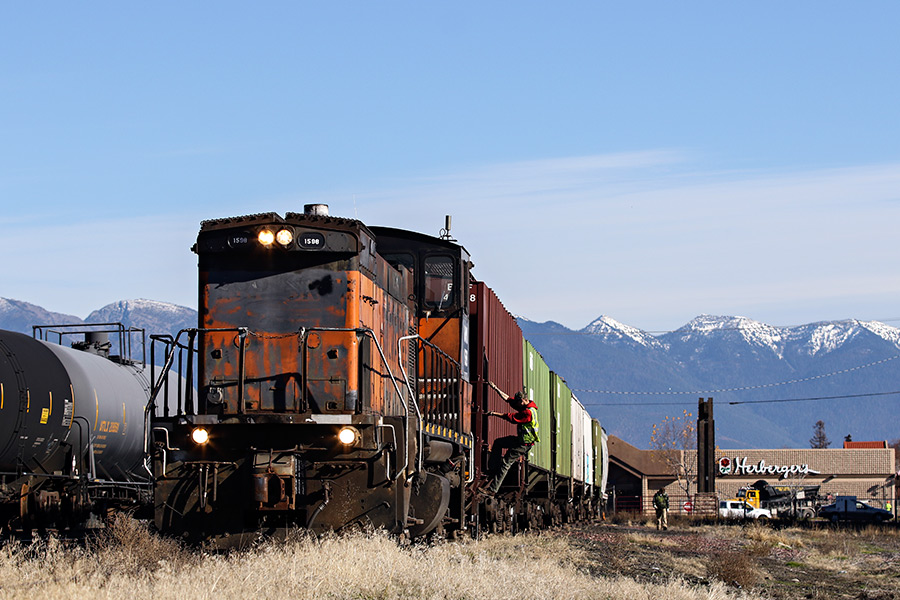If you were to stop and watch a Mission Mountain Railroad train rumble down the tracks on its way to Columbia Falls, Kalispell or Eureka, the contents of the freight cars probably wouldn’t surprise a longtime resident of Northwest Montana. There would be grain coming from the elevator in Kalispell and finished lumber from the mills in Evergreen.
But every once in awhile, there might be a commodity that would surprise you, like a gondola full of magnetite bound for a coalmine in Canada.
With changes in Northwest Montana’s economic landscape, the Mission Mountain is teaming up with BNSF Railway to expand its business and find new customers, even ones who are in another country and miles away from the short line railroad’s tracks.
“Our traditional model on the Mission Mountain has been to serve local customers that are physically located along the railroad in Kalispell, Evergreen, Columbia Falls and Eureka,” said Ted Kadau, vice president of marketing and sales for Watco Companies, the company that owns the railroad. “But we’re now looking for ways to expand our business and diversify beyond our traditional commodities.”
While trains were rolling through the Flathead Valley before Kalispell was even incorporated, the Mission Mountain is a relatively new player in the industry. From 1891 until 2005, nearly all of the tracks in the Flathead were owned and operated by the Great Northern Railway or its successor BNSF. But 11 years ago, BNSF decided to hand over its two branch lines — one between Columbia Falls and Kalispell and another between Stryker and Eureka — to Watco, which in turn created the Mission Mountain Railroad (Watco owns the route to Eureka and leases the line to Kalispell). Watco, based in Kansas, owns three dozen short line railroads across the country that operate on approximately 4,700 miles of track.
The agreement meant that BNSF — one of the nation’s largest railroad companies with more than 32,000 miles of track — could focus on moving freight on its main line through Montana while the smaller railroad could focus on getting freight the final few miles to its destination, a sometimes tedious and labor-intensive task.
Today, the Mission Mountain runs trains on a total of 35 miles of track with eight full-time employees. The railroad moves about 6,500 carloads of freight annually.
Kadau, who is based in Lewiston, Idaho and does the marketing for a number of Watco’s railroads in the region, said for years Plum Creek Timber Company, and later Weyerhaeuser, has been the railroad’s largest customer. Even with Weyerhaeuser’s decision to shutter two of its mills in Columbia Falls, the lumber producer still provides the Mission Mountain with the most freight of any of its customers. However, as the timber industry in Northwest Montana has declined, the Mission Mountain has been looking for different commodities to haul.
“The more you can diversify your railroad’s freight traffic, the more economically viable it is,” Kadau said. “Anytime you can move additional freight, it will make your railroad stronger.”
The search for more freight led to a partnership with BNSF to move magnetite — a mineral used in the coal-washing process at mines — from the seaport at Longview, Washington to Fortine. From Fortine, the mineral – which comes in 66-foot-long gondolas that can move 100 tons of material at a time – is loaded onto trucks and taken to a coalmine in southeastern British Columbia, a distance of 80 miles.
David Walker, director of rail logistics in Canada for BNSF Logistics (a subsidiary of BNSF Railway), said magnetite is mined in Mexico and South America and usually purchased by mining companies in the fall so they can stockpile it for the coming year. In previous years, BNSF or another railroad would move it from Longview all the way to Canada by rail, usually working with a railroad north of the border to get it to the final destination. But this year, they decided to work with Mission Mountain to get it to Fortine and then truck it the rest of the way.
Walker said moving magnetite via Fortine is faster because it’s a more direct route and doesn’t requiring handing off freight cars to another large railroad — a process called “interchange” — that can frequently delay shipments. At Fortine, the freight car is moved onto what’s called a “team track” and emptied at a loading dock with a front-end loader. Walker said the advantage to a team track is that many different shippers and industries can utilize it, including those north of the border.
“We think this is a good alternative to the traditional ways of moving products over the border,” Walker said. “Customers want options for how they ship commodities, and this is a great option for those shipping to Canada.”
Kadau said he is working closely with BNSF to attract more industrial shippers who may not be located along the tracks. He noted that when the Kalispell Rail Park opens in the coming years, it would also include a “team track,” offering shippers in the southern part of the region the same opportunities.
“We’re open for business,” Kadau said. “We’re very interested in talking to anyone interested in utilizing the railroad and our facilities.”
